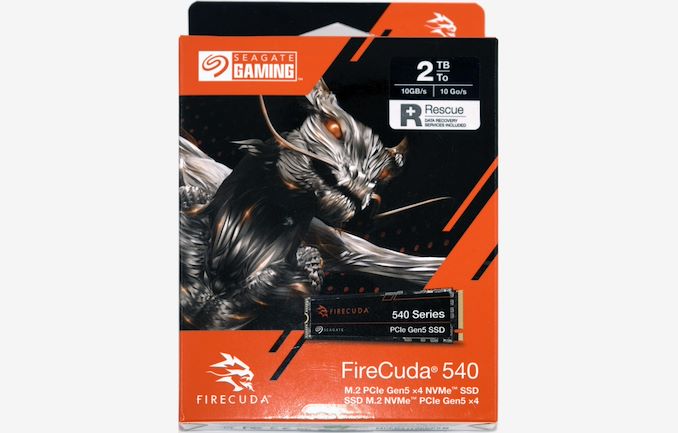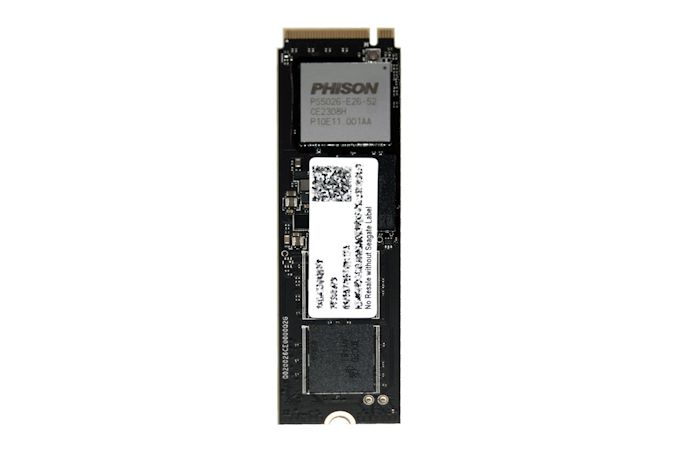Seagate Announces FireCuda 540 PCIe Gen5 SSD
by Ganesh T S on June 27, 2023 8:00 AM EST- Posted in
- Storage
- SSDs
- Seagate
- Phison
- M.2
- NVMe
- PCIe 5.0
- Phison E26
- PCIe 5.0 x4

Flash-based computer storage has been improving in speed and capacity at breakneck pace over the last decade. M.2 NVMe SSDs have almost completely replaced SATA drives for primary storage capabilities in new systems. While small form-factor machines are continuing to rely on PCIe Gen3 SSDs for an optimal balance of performance and thermal solution sizing, Gen4 SSDs - particularly of the DRAM-less variety - are slowly starting to break into that segment. However, the gaming segment in the consumer market has fueled the need for speed and created a demand for PCIe Gen5 SSDs.
Phison's E26 controller has been ruling the roost in this area, with almost all currently available Gen5 SSDs being based on it. Today, Seagate is announcing the availability of the FireCuda 540 PCIe Gen5 M.2 2280 NVMe SSD. With its PCIe 5.0 x4 interface, there is a marked increase in sequential access speeds over the previous flagship (FireCuda 530). The addition of optimizations for DirectStorage in the firmware makes it an ideal candidate for gaming enthusiasts.
The drives in Seagate's FireCuda SSD series have typically been based on Phison controllers using custom firmware (with the company's preferred term being 'Seagate-validated'), and the FireCuda 540 is no different. It is based on Phison's PS5026-E26 using the latest 3D TLC NAND (Micron's B58R 232L).

FireCuda 540 : Phison E26 Gen5 Controller + Micron B58R 3D TLC NAND
Micron's B58R 232L 3D TLC NAND can operate at up to 2400 MT/s, and these transfer rates have been used by some Gen5 SSD vendors to obtain bragging rights for the highest sequential access bandwidth numbers (in the range of 12 - 14 GBps). It appears highly likely that Seagate has decided to operate them at lower speeds and limit the overall maximum sequential rates to around 10 GBps. This should help in both the thermals and power consumption aspects.
Unlike other flagship M.2 PCIe 5.0 x4 NVMe SSDs, the FireCuda 540 does not come with a heatsink option. Rather, the company makes it a point to mention that an external cooling solution is necessary for optimal performance. With motherboard vendors offering their own SSD cooling solutions compatible with their board layout, and third-party SSD cooling solutions also in the market, this is probably a good move to keep pricing low.
Seagate is opting to release only 1 TB and 2 TB versions of the FireCuda 540 for now.
| Seagate FireCuda 540 SSD Specifications | ||||
| Capacity | 1 TB | 2 TB | ||
| Controller | Phison PS5026-E26 (PCIe 5.0 x4) | |||
| NAND Flash | 232L 3D TLC NAND (Micron B58R) | |||
| Form-Factor, Interface | Single-Sided M.2-2280, PCIe 5.0 x4, NVMe 2.0 | Double-Sided M.2-2280, PCIe 5.0 x4, NVMe 2.0 | ||
| Sequential Read | 9500 MB/s | 10000 MB/s | ||
| Sequential Write | 8500 MB/s | 10000 MB/s | ||
| Random Read IOPS | 1.30 M | 1.49 M | ||
| Random Write IOPS | 1.50 M | |||
| Pseudo-SLC Caching | Supported | |||
| TCG Opal Encryption | Yes | |||
| Power (Active / Standby) | 10 W / 144 mW | 11 W / 144 mW | ||
| Warranty | 5 years (with 3 year DRS) | |||
| Write Endurance | 1000 TB 0.55 DWPD |
2000 TB 0.55 DWPD |
||
| MSRP (non-heatsink) | $180 (18¢/GB) | $300 (15¢/GB) | ||
Other than DirectStorage optimizations, another key update seems to be the availability of hardware-based TCG Opal Encryption (that was noticeably absent in the FireCuda 530 at launch). The DRAM and flash industry is in one of the troughs of their usual pricing cycles - so this is good news for end consumers (not so much for the flash vendors). At around $150 / TB for the 2TB model, there is nothing to complain about - but do note that this doesn't include a cooling solution (which is mandatory if one is investing in a Gen5 SSD).
Source: Seagate










3 Comments
View All Comments
nandnandnand - Tuesday, June 27, 2023 - link
I don't care about PCIe 5.0 speeds. PCIe 3/4 is fine and will be throughout the decade because of the consoles.Write endurance looks better than expected. I think the last TLC drive I looked at was 600-to-1.
Silver5urfer - Tuesday, June 27, 2023 - link
Seagate FireCuda has a lot of failure problems, you can see on various places these ended up dying randomly. I suspect the Controller and Firmware. And like Samsung 980 Pro which is also having shoddy QC and caused the drive failures into read only mode. 990 Pro same issue. I do not think these are fixable issues. Plus I often see Seagate's RMA service being poor despite their DRS option. I checked on STH forums for an optimal SSD with proper endurance most of the users mention about Enterprise M.22110 standard sadly these do not have 4TB options.Plus the most important factor is linear drive performance with post pseudo SLC cache exhausted. Seagate performs much better than most but the earlier issues caused me to avoid it on top of the 530's uber high price tag. SN850 is a mess, just go to WD forum and check the mega thread about it's issue, which is basically it vanishes from the BIOS and on AMD machines it has more problems.
Ultimately due to non enterprise M.2 2280 standard we have poor quality. WD Red SN700 is looking very good but limited by PCIe3.0 although you won't even get more than 3500Mbs consistent write performance on even PCIe4.0 SSDs as it will exhaust the cache. Shame we still do not have Optane replacement, perhaps will never happen.
SanX - Friday, July 14, 2023 - link
Worst speeds among all Gen5.Absurd prices